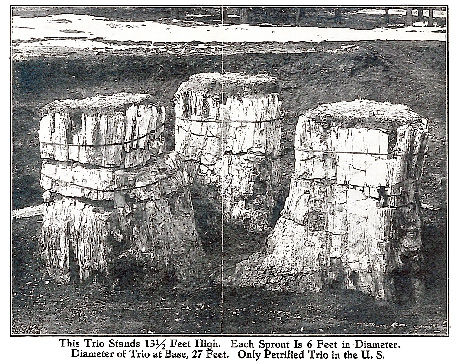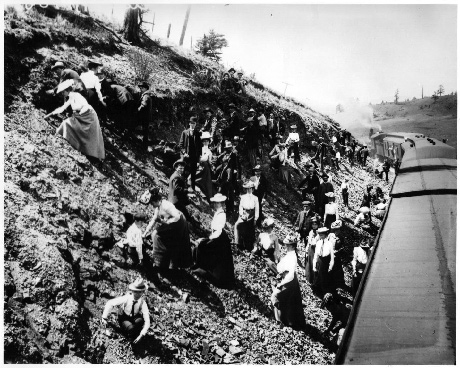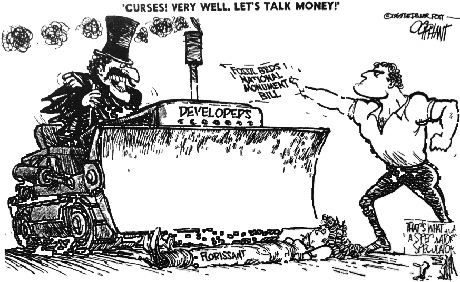|
Little
is
known about the prehistory of the area except
that the Uncompahgre Utes, also known as the
Tabeguache, were the most dominant native people
in the Florissant Valley during early
European/American colonist settlement of the
area. Culturally modified trees bear witness to
their inhabitance of the region, confirming that
the Uncompahgre likely knew about Florissant
fossil wood. The Homesteaders Act of 1862 was a
watershed moment in the settlement of the
American West, spurring new populations, and
native dispossession, of the Florissant Valley.
|
|
"I
must
admit that congress in its infinite
wisdom has not seen fit to pass
legislation protecting fossil beds in
general. However, if someone had found
the original Constitution of the United
States buried on his land and then
wanted to use it to mop a stain on the
floor, is there any doubt they could be
restrained?"
–Victor Yannacone
|
|
In 1867, the Rocky Mountain News alluded to
silicified wood near Florissant, but the first
specific historical record mentioning the
Florissant stumps dates to 1869. As early as 1876,
landowners of the Big Stump (P-16) Adam &
Charlotte Hill explored the idea of sending the
stump to the Centennial Exhibition in
Philadelphia.
|
| |
Estimated
at
over 60 tons, specimen P16 had scaffold erected
around it in 1880 to cut the stump into more
manageable sections to send to the Columbian
Exhibition of 1893 in Chicago. This attempt
failed because of the difficulties of sawing the
hard lithified wood. The site was also busy with
palaeontologists who worked with locals in
excavating Florissant’s more famous resource,
its shale beds laden with high-resolution
fossils. It was also recorded that professors
from Colorado College took Florissant wood away
by the wagonload. Further commercialisation of
paleontological resources expanded when the
Colorado Midland Rail established a station at
Florissant in 1887, further enabling tourists to
take shale-split fossils from trains originating
from Colorado Springs.
|
|
 |
| Trio , first excavated
in the 1920s, and further excavated by the
1950s. (Source: FLFO Archives, 1950s) |
| Brochure for early 20th
Century Tourism at the Bronco Dude
Ranch and Colorado Petrified Forest.
(Source: Colorado Historical Society,
1900) |
|
|
| The
site’s
value was acknowledged by many early on, and
cries for preservation were heard in 1892 in a
local newspaper: |
The oldest
settlers thereabout remembered that 20
years ago there were 20 of these petrified
trunks standing erect beside numerous
petrified logs lying over the found. All
have been removed by tourists and relic
hunters until now one of the greatest and
rarest natural curiosities of the world
has been despoiled. The trunks and logs
have been sawed up and broken to pieces
and taken East…
|
|
| The
wasteful
collection by tourists was identified by the
famous fossil collector Theodore Cockerell,
writing in 1916 that: |
It is very
unfortunate that inexperienced collectors
throw away many valuable specimens,
looking only for conspicuous ones, while
from time to time very fine things are
preserved by the non-scientific as
curiosities and are eventually broken or
lost […] in spite of the richness of the
field it is impossible to have any
assurance that species so represented will
ever be found again […] To lose or destroy
them is like removing a brick from some
splendid building; the building will not
fall, but the offense is intolerable.
|
|
|
| Brochure for early 20th
Century Tourism at the Bronco Dude
Ranch and Colorado Petrified Forest.
(Source: Colorado Historical Society,
1900) |
|
|
|
 |
| Tourists and fossil
collectors taking advantage of the
Midland Rail stop at the Florissant
fossil-laden shale beds. (Source:
Colorado Historical Society, 1900) |
|
Later families exploited the
tourist potential of their land, and their
facilities included a lodge with a petrified tree
fireplace, display cases of collected fossils, and
had an ancillary function as a dude ranch.
In 1918 the Cripple Creek Touring Company
uncovered three large stumps, perhaps in response
to dwindling tourist drawing resources, but also
to compete with the income generating tourist
attraction that the Coplen family had developed.
These stumps were speculatively curated in 1922 by
property owners David and Ira Henderson on land to
the south of the Coplen Petrified Forest and Big
Stump and developed what would become the
competing tourist attraction named the New, then
Henderson, and finally Pike Petrified Forest.
Their efforts were rewarded with the highlights
‘Trio’. These are very dramatic stumps, one over
4.1 metres in diameter, and the Trio being a clone
with three trunks like no other in the world. It
has been anecdotally noted that dynamite was used
during the excavations, and while there is
insufficient archival evidence to confirm it's
use, it may explain the universal cracking found
on these specimens. |
|
| Walt
Disney
visited the site in 1956 and purchased a
large stump for $1,650. This five ton
stump remains on display in Disneyland’s
Frontierland in Los Angeles today. |
|
In the Summer of 1969 the Colorado
state court in Denver heard one of the first
strictly environmental legal cases. Relations
were heated between the Defenders of Florissant,
Inc. and real estate developers wishing to turn
the valley with its enormous collection of
fossils into a housing development. There is no
doubt that the primary source of heritage value
at FLFO is its paleontological resources, and
for this reason the lawyer Victor Yannacone
argued that to bulldoze Florissant fossil lands
would be akin to, “using the rosetta stone for
grinding corn.” Florissant Fossil Beds National
Monument was officially enacted in 1969.
|
Over
time, touristic display at the Pike Petrified
Forest, and with NPS control, involved various
podiums and walkways, including two different
podiums directly on top of P46, and later the NPS
crater walkway named the “Then And Now Trail” from
the 1970s.
In the late 1990s the most vulnerable stumps,
those excavated by dynamite, were enclosed in
temporary Yurts until permanent shelters without
walls were erected. The old Pike Petrified Forest
building became the NPS Visitor Center, which was
demolished in 2011 to make way for the
contemporary visitor, research, and maintenance
complex.
|
 |
A depiction of the
battle between the Defenders of
Florissant from the newspapers at the
moment of the National Monument bill.
(Source: Pat Oliphant’s cartoon in
Leopold & Meyer, 2012)
|
|
|







